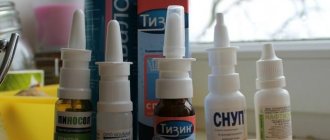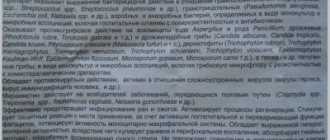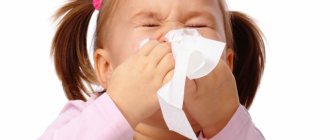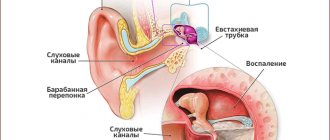Can chamomile cure a cold?
Typically, a cold in a child manifests itself as inflammation in the nasopharynx and oral cavity, caused by the activation of opportunistic microflora against the background of hypothermia and a weakening of the body's defenses. Colds include:
• rhinitis; • sinusitis; • nasopharyngitis; • laryngitis; • tracheitis; • chronic tonsillitis; • adenoiditis.
Colds can be easily cured with herbs, but for respiratory infections such as sore throat, flu or severe cases of acute respiratory viral infection, chamomile alone will not be enough. The patient needs etiotropic therapy with individual selection of antibiotics or antiviral drugs; herbal medicine plays a supporting role.
Chamomile against colds: what pediatricians say
Herbalists allow you to do whatever your heart desires with chamomile - drink it in the form of a decoction and infusion, gargle, do inhalations, rinse your nose. Scientific medicine has a different opinion on this matter. Since it has been proven that the anti-inflammatory effect of the plant in the fight against colds is more pronounced when applied topically, chamomile is prescribed for children with a sore throat for gargling, and for rhinitis - for rinsing the nasal cavity.
Not all topical remedies are equally effective. In particular, hot foot baths with chamomile are recognized as a means of distraction, and in the form of a hot decoction for inhalation, chamomile will help children with a cough only after the cessation of the acute inflammatory process.
For acute infections, inhalations with chamomile are harmful, since heat exposure promotes the proliferation of microbes. It is also prohibited to use chamomile oil in compression inhalers and nebulizers, otherwise it will end in pneumonia.
Children under 3 years old should not be given chamomile at all, since evidence of its safety for young children has not yet been obtained. In infants, chamomile decoction can cause diarrhea, and if used frequently, it also interferes with the absorption of iron. For these reasons, chamomile for colds for children under one year old is allowed only in the form of nasal drops. Children over 3 years old can drink chamomile infusion or tea as a mild expectorant and diaphoretic.
Beneficial properties of chamomile
Chamomile flowers contain a large list of vitamins and microelements. They contain coumarins, flavonoids, ascorbic acid, carotene, choline, polysaccharides and organic acids. Chamomile infusion is beneficial for the circulatory, immune, nervous, and digestive systems. Chamomile tea:
- has antispasmodic and anti-inflammatory effects;
- relieves nervous tension;
- reduces intestinal spasms, improves digestion;
- strengthens the immune system, activates the body's defenses;
- effective in fighting infections;
- has analgesic properties.
Chamomile tea is useful for children because it helps get rid of colic in the tummies that haunt babies. In infants, the intestinal microflora is not formed; food is not always digested correctly. This may cause increased gas formation, constipation or diarrhea. All this is accompanied by painful sensations in the abdominal area. The child cries, sleeps poorly, loses weight. After examining the pediatrician, if he does not find other causes of pain and crying, you can give the baby chamomile tea.
Chamomile flowers can be used to prepare a decoction. You can bathe a newborn in it. Chamomile has a beneficial effect on the skin and relieves irritation that may occur from the diaper. Chamomile helps well with prickly heat and allergic rashes. Baths with the addition of this plant promote sound sleep as they calm the child.
How to brew chamomile for a child
For small children from 1 to 3 years old, only weak chamomile decoctions and diluted chamomile tea are suitable. Infusions can only be used after 5 years, as they may contain harmful impurities that are destroyed by heat treatment.
Safe concentrations of bioactive phytocomponents for children are lower than for adults. To prepare the decoction, you need 1–1.5 teaspoons of dry raw materials per one and a half glasses of water (300 ml). The dried inflorescences are poured into an enamel pan and simmered in a water bath for about half an hour, then cooled, filtered and infused for 40 minutes, and then boiled water is added to the original volume.
If the child is prone to allergies, place the pan on low heat and boil the liquid for 3-4 minutes. In this case, the loss of active substances is small, but the decoction will be completely cleared of inclusions.
To brew chamomile tea you will need three tablespoons of flower heads and half a liter of boiling water. The flowers are poured with hot water, the teapot is wrapped in a towel and left for an hour or two. For one cup of tea, take 2-3 tablespoons of tea leaves.
Chamomile infusions for internal use are prepared at the rate of one large spoon of inflorescences per glass of hot water. Flower baskets are poured into a thermos, filled with water, wrapped and allowed to brew for about four hours. Infusions for rinsing are prepared in the same way as tea leaves.
How to properly prepare chamomile tea
Chamomile tea is really easy to make so you can enjoy it every day. This is a mild tea, which means it can be enjoyed over a long period of time.
Here are some tips on how to make chamomile tea
.
Parts used:
dried flowers and leaves.
Water temperature:
100ºC (boiling).
Quantity:
2 tsp.
/ cup (250 ml). Boiling time:
5-10 minutes.
Recommended dosage:
3-4 glasses per day, between meals or before bed.
Sweetener:
honey
Herbal tea is made from dried chamomile flowers and leaves.
Store the herbs in a tightly sealed jar in a dark, cool place and only take them out when you need to make the tea.
- Start with boiling water. While you wait for the water to boil, prepare the kettle and cups.
- Place 2 teaspoons of dried flowers and leaves per cup of tea (about 250ml) in your teapot.
- Pour boiling water over it. Let it brew for at least 5 minutes, but it is better to wait 10 minutes if brewed in a large kettle.
- Strain to obtain a delicate yellow tea with a wonderful floral aroma.
The tea can taste quite bitter, so you can sweeten it to taste. Honey is a great choice if you drink chamomile tea when you have a cold or an upset stomach. If it's too bitter, you may have steeped it too long or used too much chamomile. Adjust the balance to your taste.
When chamomile is useful: dosage and rules of use
Children from 3 to 9 years old are given decoctions and infusions of chamomile to drink a quarter glass three times a day; for a teenager 10–16 years old, the single dose is increased to a third of a glass. If your baby is naughty, sweeten the medicine with honey. The duration of the course is from 2 weeks to a month or more.
To gargle and wash the nose, use a warm decoction or tea of chamomile, diluted with boiled water in a ratio of 1:2. Before use, add salt to the liquid - a teaspoon per liter. The procedures are repeated up to 4–5 times a day for a week. Ready-made decoctions, infusions and chamomile teas are stored in the refrigerator for no more than two days.
A growing body sometimes exhibits unpredictable reactions to medications. Take chamomile under the supervision of a pediatrician - the doctor knows more about the beneficial properties of herbs than the neighbor's grandmothers!
Source
Side effects of chamomile tea
Although chamomile herb has been used for many years and is completely safe in many places around the world, there are some aspects to pay attention to.
The overly calming effect of chamomile
- The calming nature of chamomile may be harmful to people with low blood pressure, causing weakness.
While chamomile tea is a natural sedative, it should not be taken while driving. Chamomile tea can cause drowsiness and can be dangerous when you need to be alert.
Too much chamomile in herbal tea is not always beneficial
- Some people may develop tolerance to the sedative properties of chamomile. Drinking too much chamomile tea can be harmful to your stomach. If you exceed the recommended daily dose, you may experience nausea and even vomiting.
If you have sensitive skin, you may experience skin reactions and allergies. Especially if you drink too much chamomile tea. This is very rare, but if you have any symptoms, you should stop drinking this tea.
Chamomile tea and pregnancy
It may be tempting to drink a chamomile infusion when you're pregnant to help combat nausea. However, too much tincture can shrink the uterus and cause miscarriage.
It is best to consult your doctor to get a recommendation and the correct dosage for your specific case.
Allergies and drug interactions
- If you are allergic to plants such as ragweed or chrysanthemum, if you suffer from asthma or suffer from pollen allergies, then it is best not to drink chamomile tea.
- If you have trouble breathing or swallowing, cramps, or general pain, stop drinking chamomile tea immediately and see a doctor to be tested for allergies.
Chamomile herbal tea may interact with a drug you are taking. Therefore, try not to drink chamomile tea if you are taking blood thinner medications or taking medications for epilepsy. The effects of the medicine may be increased beyond safe levels.
Quick treatment of a runny nose in a child using folk remedies. Chamomile flowers for a runny nose
A runny nose is an extremely unpleasant condition. It prevents you from sleeping, enjoying the world around you, and simply living. In addition, if it is not treated in time, serious complications may arise: various sinusitis, for example.
One of the ways to alleviate the condition of a patient with a runny nose is to rinse the nose with saline solutions or herbal decoctions. Many people are interested in whether it is possible to rinse their nose with chamomile.
Washing is a hygienic procedure. It allows you to get rid of excess nasal mucus, which can be produced a lot during illness.
And along with snot, foreign particles, pathogens and allergens are washed away
.
That is why rinsing is prescribed as part of the complex treatment of diseases such as rhinitis, including chronic rhinitis, and others, ARVI, and so on.
Remember!
If you use decoctions of medicinal herbs for rinsing, the procedure can become not only hygienic, but also therapeutic.
Chamomile is one of the most famous and frequently used medicinal plants. There are several reasons for this.
Chamomile is very useful: it relieves inflammation, fights germs, soothes, and promotes speedy healing.
In addition, this herb extremely rarely causes allergic reactions. This is why chamomile is used, among other things, to treat children.
Chamomile decoction is widely used in the treatment of colds . You can drink it instead of tea, use it for inhalation, and gargle with it.
Sometimes parents are advised to drop chamomile into their child’s nose to get rid of a runny nose.
Attention!
No matter how rare an allergy to chamomile is, it still exists; be careful about how you feel after using the decoction.
Chamomile is also used for rinsing the nose. How to rinse your nose with chamomile? Let's figure it out.
Simple rules
First you need to prepare a decoction. For this you will need, of course, chamomile .
You can buy it at the pharmacy, or you can collect it yourself in the summer, away from the city and roads, and then dry it.
Two tablespoons of dried herbs are poured into a glass of cold water.
Now the container needs to be placed on high heat and brought to a boil.
Then remove from heat, cover with a lid and leave for 40 minutes to brew. Then the resulting liquid is filtered, now it can be used for.
Types of chamomile drinks for children
Which chamomile tea is more beneficial for a baby? How to choose chamomile tea?
When choosing chamomile flowers, preference should be given to those sold in pharmacies , since such products undergo careful control before hitting the counter.
Pharmaceutical chamomile . The flowers of this plant are most often sold packaged in disposable filter bags in crushed form or in packages with whole heads in dry form. To prepare this tea, just pour one bag with one glass of hot water, and then leave to brew for 15 minutes.
Tea on store shelves . You can purchase granulated chamomile tea for babies. In this case, it is very important to pay attention to the composition; it should not contain any dyes or flavors. Each package of this drink contains instructions on the brewing method.
Composition and beneficial properties
Pharmaceutical chamomile is an effective remedy for colds for rinsing a child’s nasopharynx.
It has valuable healing properties: bactericidal, anti-inflammatory, antiseptic, antifungal, wound healing, soothing, antispasmodic.
The plant contains bioflavonoids, phytosterols, and bitterness. The composition also contains mineral salts, glycosides, matrices, choline, carotene, coumarins, chamazulene, alkaloids, tannins, vitamins C and PP.
The powerful therapeutic effect is explained by the presence of organic acids: linoleic, oleic, stearic, caprylic, nicotinic, antimisic, isovaleric, palmitic.
Thanks to such a diverse chemical composition, chamomile flowers are effective in treating many colds. All parts of the plant have healing properties, but chamomile flowers are more often used for treatment.
Chamomile for a runny nose is used in many ways: taking a decoction orally, nasal drops, inhalation.
Internal use
It is believed that an infant should not consume any herbal infusions.
Of course, you need to take precautions by consulting your doctor. In most cases, if used correctly, no problems arise. It is very important to choose the right dosage, calculate the volume of the drink and take into account the age of the baby. You need to start with a weak concentration of the decoction. Chamomile infusion for internal use is prepared in the usual way: 1 tbsp. l. pour a glass of boiling water and leave for half an hour, filter. The decoction is ready. For a child up to one year old, it is enough to take 1 tbsp. l. 3 times a day before meals.
Chamomile decoction is an excellent immunostimulant and an effective remedy for fighting the common cold.
How much chamomile tea can you give your child?
For the first acquaintance, 15 ml is enough; monitor the child throughout the day. If there are no signs of allergy in the form of tummy pain or rashes, you can offer 20 ml, after a couple of days, having reached 30 ml, you should stop there.
This amount is enough to offer to a baby in case of stomach upset and colic once a day. After a year, a child can be given no more than 150 ml of chamomile once a day, the safest option is 60-90 ml.
Nasal rinsing
Dropping a warm decoction into the nose is an excellent natural remedy for a runny nose.
Is it possible to rinse a baby's nose with chamomile? In infants under one year old, it is difficult to treat colds. There are very few safe natural remedies. Chamomile is an ideal choice. The decoction can even be dripped into the baby’s nose.
If a child has difficulty breathing through the nose, then using a low concentration decoction is quite safe. It is best to brew chamomile tea bags. This greatly simplifies the process of preparing the medicine. To begin with, it will be enough to brew 1 bag of chamomile with a glass of boiling water, later the concentration can be doubled. You can use dried flowers: 1 tbsp. l. per glass of boiling water. After cooling, strain through cheesecloth or a fine sieve. You can infuse the herb in a thermos. If the concentration of the medicine is too saturated, dilute with boiled water. Clean your nose before the procedure. It is necessary to drip a few drops of warm infusion into the nose 3 times a day.
Rinsing the nose with a decoction of the plant makes breathing easier. Usually rhinitis goes away quickly and without complications.
There are opponents of the chamomile treatment method. They believe that as a result of its use, the nasal mucosa in infants is disrupted. Negative consequences can be avoided by selecting the correct dosage and moderate use of the drug. To avoid drying out the mucous membrane, use a weak decoction.
Chamomile flowers contain essential oils that have an antiviral effect. When you have the flu, using the herb relieves the condition. When you have a runny nose, your nose becomes clogged with mucus, making breathing difficult. The infusion dilutes the contents of the nasal sinuses, promoting its removal.
Inhalations
The inhalation procedure is considered the most effective for treating a runny nose. But it is better to use this method for children older than one year. It is necessary to inhale the steam of the infusion not only through the nose, but also through the mouth.
For younger children, the duration of inhalation should not exceed 5 minutes, and to avoid burns to the respiratory tract, the procedure should be carried out very carefully. Usually there is a significant improvement in nasal breathing, and the inflammatory process of the nasal mucosa quickly stops.
It is safer to treat a baby’s nose in other ways.
Chamomile infusion is widely used in pediatrics; this remedy is also popular in folk medicine. It is better to treat a runny nose in a newborn child without the use of medications.
Despite the safety of its use, there are contraindications. Children with allergic reactions should be used with caution. In case of individual intolerance, it is necessary to refuse treatment with this drug.
Before use, it is advisable to consult a doctor, specifying the dosage in accordance with the age characteristics of the baby. Improper use of the plant can harm the child.
The main advantage of chamomile treatment is its effectiveness and safety. This is an indispensable remedy for treating a runny nose in infants; it has a pleasant taste and is very gentle, which is important for treating babies.
Chamomile is a plant from the genus Compositae, it is widely used both in the cosmetic industry and in medicine. When dealing with colds in newborns, young mothers try not to use various medications and try to replace them with natural remedies. Is it possible to drop chamomile into a baby’s nose with a runny nose? Let’s try to find out in this article.
Chamomile is an annual plant with a specific strong odor, its height is no higher than 40 cm. The flowers of the plant are used in medicine. The flowering period is from the second half of May to the first half of September. They begin to harvest the medicinal plant for medical purposes from the end of May to the second half of August. It grows as a weed on the edges of roads, ravines, meadows, and slopes. In some regions it is grown on special farms. It is more common on the Eurasian continent and in the northern part of America.
Chamomile contains the following substances:
- flavonoids;
- carotene;
- essential oil;
- choline;
- ascorbic acid;
- coumarins;
- chamazulene;
- organic acids;
- glycosides.
This plant is one of the few that is used for almost all diseases. The therapeutic effect occurs due to the properties of chamomile or, as it is called in Latin, Chamomilla recutita.
The plant is used in medicine as:
- antispasmodic;
- antiseptic;
- depressant;
- anti-inflammatory.
When using a decoction or infusion from this plant internally or for washing, the patient’s digestion improves, blood vessels dilate, breathing deepens, and pathogens are eliminated.
Application
Chamomilla is used in both folk and traditional medicine. Chamomile is taken in the form of decoctions, tinctures, and tea. This plant perfectly relieves the inflammatory process from the surface of the mucous membranes of the nasopharynx, stomach, and intestines. In addition to quickly and effectively eliminating symptoms, it also treats the cause of the disease.
A lasting therapeutic effect appears with the systematic use of chamomile for 7-10 days. To completely get rid of the problem, it is necessary to use a medicine from this medicinal plant from several weeks to 1.5 months. Sometimes, according to indications, treatment can be extended to 3 months or more.
In traditional medicine, some preparations are made based on chamomile extracts, for example, Rotokan, Ayurom, Romazulon, and essential oil. They mainly have an anti-inflammatory effect.
Can a baby's nose be treated with chamomile?
At the present stage, there are a huge number of different drugs that are offered to newborns for the treatment of colds. The child’s body is not yet formed and the internal organs can negatively perceive any drug, therefore, under the age of 3 years, parents try to avoid the use of medications.
Chamomile medicines are widely used by young mothers. Moreover, they are safe. In addition to chamomile, other medicinal plants are added to home remedies - string, calendula, mint. Decoctions, teas, and infusions are usually prepared.
You can prepare the raw materials for treatment yourself, but since this is not always possible, it is better to purchase a certain composition at the pharmacy.
What is better to drop into a baby’s nose, a decoction or an infusion? These types of medicinal drugs are equally useful and safe. Choose according to the type of disease and the degree of its development.
Chamomile home remedies are used for rhinitis and other problems associated with the nasopharynx, as they speed up the healing process.
Children's chamomile tea is useful for coughs. Also, at the time of teething, some children develop such unpleasant phenomena as a severe runny nose and itchy gums. In this case, it is appropriate to rinse the nose with a decoction or infusion and lubricate the gums.
Contraindications and age restrictions
There is no obvious age limit for taking chamomile; the main thing is to observe the proportions and prepare the decoction correctly.
- Contraindication is individual intolerance to chamomile. You should be careful when offering tea from this plant to your baby for the first time. You need to start with minimal doses. If even the slightest manifestation of an allergy occurs, you should stop taking the drug.
- It is forbidden to take chamomile tea along with diuretics and sedatives. Chamomile has a sedative and diuretic effect, so an overdose may occur when taking medications.
- You cannot self-medicate or prescribe chamomile tea to your child on your own, without the knowledge of the pediatrician.
- Chamomile does not allow iron to be fully absorbed, so large amounts of a drink made from it are contraindicated for breastfed children.
You may be interested in: St. John's wort tea for beauty, youth and health
Recommendations for taking chamomile tea
When your child takes chamomile tea, you must strictly follow the dosage prescribed by your doctor. To relieve pain and calm a child with intestinal colic, it is enough to give him 15 ml of tea after feeding. A baby under one year old should not drink more than 100 ml of drink per day. Be sure to monitor the baby’s condition the entire time you take it; if an allergic reaction occurs, you should consult a doctor; you should stop taking chamomile.
For children after 5 months, chamomile decoction will help get rid of coughs due to colds. Chamomile decoction can be given 30 ml warm three times a day. Children from one to 3 years of age should increase the dose to 50-65 ml. This decoction can relieve inflammation and have an expectorant and diaphoretic effect.
How to prepare chamomile-based potions?
Preparing decoctions and infusions does not take much time. Children often get sick, and it is necessary to master the skills of making medicines at home. Here are the recipes for basic potions made from Chamomilla flowers.
Decoction
Prepared in several ways:
- Place 20 grams of chamomile flowers in a glass and top up with boiling water. Wait an hour, strain and use, diluting with warm water 1:1. It is recommended to drop the resulting composition into the child’s nose at the initial stage of a runny nose as an antiseptic. For infants, be sure to dilute the mixture with water so as not to dry out the nasal mucosa. Place a few drops into the nasal passages and help blow the nose if the baby can already sit. Otherwise, you need to turn the child on his side, and after instillation, pick him up and hold him in a horizontal position until the snot flows out along with the broth.
- If you want to make a stronger decoction, you should pour not 20, but for example, 40 or 50 grams of flowers into an enamel bowl and pour a glass of hot, clean water. Place in a water bath and leave for half an hour. Then strain and add water before use. In concentrated form, a newborn should not drip the infusion into the nose.
- Place 40 grams of dry raw materials in a small saucepan, preferably enameled. Fill with water, you need at least 250 ml. Place on the fire and let it simmer for a few minutes. It is not recommended to boil for a long time so that the medicine does not lose its healing properties.
Chamomile is used in the nose only after consultation with a pediatrician. If the runny nose is simply physiological and little mucus is produced, then there is no need to treat it at all, it will go away on its own.
Infusion
Like a decoction, it is used to eliminate external and internal diseases. To instill or rinse the baby's nasopharynx and nose, you can prepare this infusion.
Pour a tablespoon of dried flowers into a thermos and pour boiling water, about 250 ml, and leave for an hour. In a thermos, the liquid does not spoil and remains hot for a long time, so you can prepare an infusion for several days. To do this, add a double portion of the dry ingredient and also increase the amount of water.
Before use, dilute with warm water to make the drug acceptable for use. It cannot be used hot; it can burn the nasal mucosa. To make it easier for a child with rhinitis to breathe through his nose, the infusion must be instilled several times a day. At one time, 2 drops into each nasal turbinate are enough for the baby.
Tea for children
You can drink tea for preventive or therapeutic purposes. It is not recommended to use chamomile tea unnecessarily for an infant. Once a day, instead of water, you can give chamomile tea if the child sleeps restlessly or often wakes up and is capricious. It is also effective for runny noses and coughs, or when the baby’s gas does not pass.
The tea is prepared as follows. Pour a few teaspoons of flowers into a clean glass or teapot. Pour in freshly boiled water and cover with a lid or saucer.
You need to infuse longer than regular tea leaves to reveal the properties of the medicinal plant, about 20 minutes. Then pour a little tea leaves into a clean cup and dilute with boiling water. Cool slightly until the drink is warm but not hot. Pour into a bottle and give to your baby to drink. It is not advisable to use chamomile tea more than 2 times a day.
Contraindications
Although chamomile drugs are considered absolutely safe, you should not abuse them. Medicines prepared at home from this plant are contraindicated if the child is allergic to chamomile or has an individual intolerance to the product.
Chamomile, in some cases, is an irreplaceable medicine, but it must be used according to indications. Before use, you must consult your pediatrician. Remember, your child's health is in your hands.
In general, chamomile can be dripped into the nose of a child, including infants, and in some cases even a newborn baby. However, the benefits of such procedures are extremely small; it is impossible to cure a child’s runny nose using chamomile-based products. At the same time, chamomile decoction or infusion can cause side effects in a child. Consequently, the feasibility of these procedures is questionable, since the benefits from them often do not compensate for some of the possible risks.
Nasal congestion in a newborn baby is an absolutely normal condition. It should not be treated, including with chamomile.
If you instill chamomile into a child’s nose correctly, such procedures are quite safe. The components of the solution do not penetrate into the blood and do not have a systemic effect on the body, and cannot cause any general side effects.
Both decoction and water infusion of chamomile have the same properties. They are approximately equally safe, but are also approximately equally likely to cause side effects when instilled into a child’s nose.
At the same time, children are quite sensitive to various aggressive and irritating substances that enter the surface of the nasal mucosa. The younger the child, the more likely it is that chamomile decoction or infusion will cause him an allergy or irritation of the mucous membrane of the nasal passages, which will result in an increase in runny nose. Therefore, chamomile can be dripped into the nose of children under 5 years of age only with the agreement of a pediatrician and with constant monitoring of the baby’s condition.
Chamomile for colds
Chamomile can be used for colds in a variety of ways. As mentioned above, various decoctions and infusions are prepared from it, which are then either taken orally or used externally.
For example, chamomile is considered a very effective remedy for runny nose during colds, which can be used to treat both children and adults. The nasal passages are washed with a decoction or infusion prepared from it, using a special teapot with a rounded spout, which can be purchased at any pharmacy.
If, when treating a child, he does not allow the nasal passages to be washed, then to eliminate a runny nose, you can use a strong infusion, literally putting 1-2 drops into each nostril.
For severe cough and poor sputum discharge, chamomile oil, infusions and decoctions from it are used for inhalation. To do this, brew the herb or add oil to hot water and inhale the emanating vapors for 5-10 minutes.
When treating a small child, steam inhalations should be carried out very carefully, since any incorrect action can lead to burns of the mucous membranes. In this case, it is recommended to simply place a pan with a decoction or infusion of chamomile on the stove and hold the baby in your arms near it so that he simply inhales the moistened air. You cannot tilt it towards the pan!
The beneficial properties of the plant also appear when its decoctions are used to gargle. In this case, chamomile acts as an antiseptic and pain reliever.
It effectively eliminates swelling in the throat, relieves inflammation and disinfects. Relief from its use is noted already on the second day, but provided that all the rules are followed. Namely: you only need to gargle with warm, freshly prepared decoction or infusion (not hot!) every 2-3 hours.
For cramps and body aches, she recommends doing foot baths with chamomile infusion for 10-15 minutes. But the use of this method is possible only in the absence of high temperature. Chamomile tea is considered no less useful, especially in combination with lemon and honey. This remedy can literally put a person on his feet in a few days.
Drinking this tea provides:
- normalization of body temperature;
- elimination of headaches, body aches;
- improved nasal breathing;
- relief of sore throat;
- strengthening the immune system.
Chamomile is a unique plant. Due to its complex effects on the body, even modern doctors who are opposed to alternative medicine recommend using it as an additional therapy for respiratory diseases in children and adults.
The advisability of putting chamomile in a child’s nose
As a rule, people try to drop chamomile into a child’s nose to relieve a runny nose. It is known that chamomile decoction or other preparations of this plant can have an anti-inflammatory effect, and therefore many parents try to relieve swelling and eliminate nasal congestion with the help of these remedies. They also expect that natural plant-based drugs will be safer than drugs with synthetic active ingredients.
In reality, it is impossible to get rid of a runny nose in a child using chamomile.
Even its anti-inflammatory effect is not so pronounced that it would relieve the baby of nasal congestion. With the help of chamomile preparations, you can only slightly reduce the swelling in the nose, and the water in their composition will help thin the snot, remove it more quickly from the nose, and, as a result, clear the nasal passages and slightly normalize breathing.
Why can’t you always drop chamomile into a child’s nose?
A child with typical symptoms of allergic rhinitis
Chamomile can cause allergies when dropped into the nose
. The younger the child, the higher the likelihood of such a reaction to any chamomile remedies. For this reason, it is most risky to drop chamomile into the nose of a newborn - in the first weeks of life, the nasal mucosa can react with swelling to almost any substance. The components of chamomile raw materials, as biologically very active substances, can all the more cause such reactions. Despite the fact that, in general, chamomile does not pose a serious danger to a newborn baby, it is undesirable to instill his nose with products based on it.
For children under one year old, only in consultation with a doctor, you can try drip one drop of chamomile decoction or infusion into the nose and observe whether signs of allergy or irritation develop: sneezing, tearfulness, increased runny nose, rashes on the face. If they are not there, you can continue instillation.
It is strictly forbidden to drip chamomile to a child with obvious allergic rhinitis. In this case, any chamomile preparations can intensify the symptoms of the pathology, especially in preschool children.
Benefits of Chamomile Tea
Let's consider all the benefits for children under one year old point by point:
- Studies have shown that chamomile tea helps control colic in newborns, even chronic ones.
- Chamomile is a natural relaxant and can be useful in cases where a child has disrupted sleep patterns
- various compounds relax the digestive tract, thereby promoting digestion and preventing the production of gas
- There is a faster improvement in health during colds, and reduced inflammation of the upper respiratory tract thanks to antioxidants
- the infusion may be useful when a baby suffers from an inflammatory skin condition such as sunburn or diaper rash, or when gums become sore during teething
- may reduce the intensity of some gastrointestinal conditions such as irritable bowel syndrome and gastroesophageal reflux.
Please note that there is not enough research on the benefits of chamomile for adults, let alone children, so again, follow the advice of your pediatrician.











